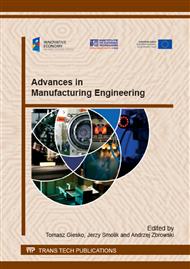[1]
A. Marchewka, Z. Lutowski B. Marciniak, M. Śrutek, S. Bujnowski, Control Algorithms in Multi-agent environment, Image Processing & Communications, Vol. 17, No. 3, (2012) pp.47-62.
DOI: 10.2478/v10248-012-0021-3
Google Scholar
[2]
I. Beker, V. Jevtić, D. Dobrilović, Shortest-path algorithms as a tools for inner transportation optimization, International Journal of Industrial Engineering and Management (IJIEM), Vol. 3 No 1, (2012) pp.39-45.
Google Scholar
[3]
T. Marciniak, Z. Lutowski, S. Bujnowski, D. Boroński, P. Czajka, Dual-Band Experimental System For subsurface Cracks Testing, Materials Science Forum Vol. 726 - Fatigue Failure and Fracture Mechanics, Trans Tech Publications, (2012) pp.222-226.
DOI: 10.4028/www.scientific.net/msf.726.222
Google Scholar
[4]
B. Marciniak, T. Marciniak, Z. Lutowski, S. Bujnowski, Usage of digital image corelation IN analysis of cracking, Image Processing and Communications. Vol. 17, No 3, (2012) pp.21-29.
DOI: 10.2478/v10248-012-0019-x
Google Scholar
[5]
L. Peng, H.Y. Liu, Decision-making and simulation in multi-agent robot system based on PSO-neural network, International Conference on Robotics and Biomimetics, (2007) pp.1763-1768.
DOI: 10.1109/robio.2007.4522432
Google Scholar
[6]
S. Sung-Oog, L. Jung-Oog, B. Doo-Kwon, A Mobile Agent-based Multi-Robot Design Method for High-Assurance, 10th IEEE High Assurance Systems Engineering Symposium,. HASE '07, (2007) pp.389-390.
DOI: 10.1109/hase.2007.30
Google Scholar
[7]
P. Guerrero, J.R. del Solar, M. Romero, L. Herrera, An integrated multi-agent decision making framework for robot soccer, 6th Latin American Robotics Symposium (LARS), (2009) pp.1-6.
DOI: 10.1109/lars.2009.5418321
Google Scholar
[8]
B. Boryna, B. Dubalski, P. Kiedrowski, A. Zabłudowski: Errors Nature in Indoors Low Power 433 MHz Wireless Network, Image Processing and Communications Challenges 2, Springer Verlag, Advances in Intelligent and Soft Computing 84, (2010).
DOI: 10.1007/978-3-642-16295-4_43
Google Scholar
[9]
P. Kiedrowski, B. Dubalski, B. Boryna, J. Lis: Bezprzewodowa sieć telemetryczna zrealizowana w oparciu o układy nadawczo-odbiorcze krótkiego zasięgu, Rynek Energii nr 1 (92), (2011) p.108–114.
Google Scholar
[10]
M.A. Khamis, W. Gomaa, Enhanced multiagent multi-objective reinforcement learning for urban traffic light control, International Conference on Machine Learning and Applications (ICMLA), (2012) pp.586-591.
DOI: 10.1109/icmla.2012.108
Google Scholar
[11]
L. Chun-Jie, Building of searching behavior analysis models on multi-agent intelligent agent technology, Symposium on Electrical & Electronics Engineering, (2012) pp.574-577.
DOI: 10.1109/eeesym.2012.6258722
Google Scholar


